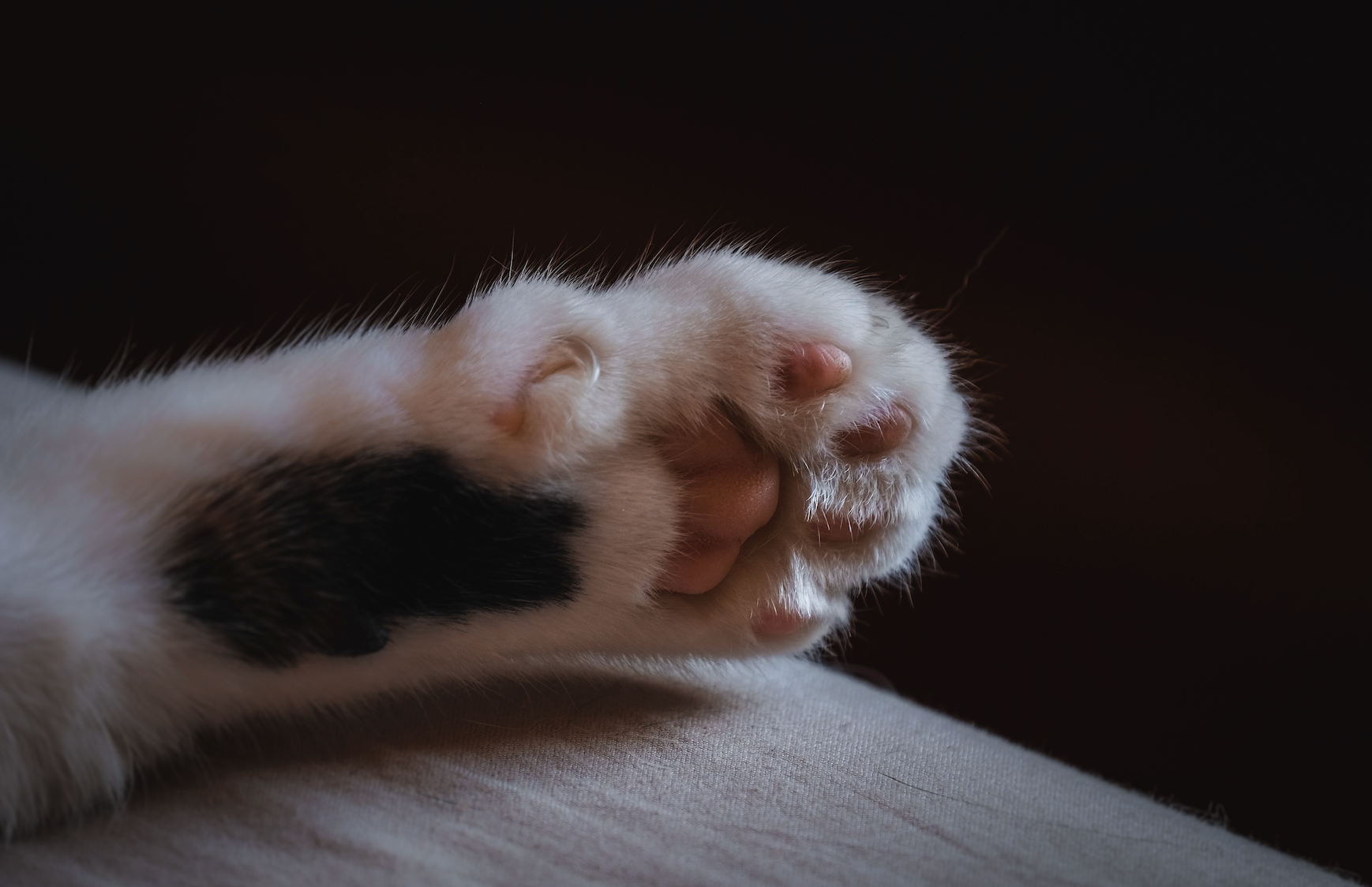The Science of Cat Toe Beans
December 13, 2023

If you're unfamiliar with the term 'cat toe beans', like I was, you'll be charmed to learn it's a delightful nickname for the digital pads on your cat's toes. These toe beans, as cat lovers fondly call them, are the adorable, squishy pads on the underside of a cat's feet.
Typically, cats have four of these toe beans on each paw if they have the standard five toes on their front feet, with two of these being the less visible dew claws.
This cute term captures the endearing nature of these small, often pink, cushion-like parts of a cat's anatomy, which add to the overall cuteness of our feline friends. But they’re known for more than just being cute.
Cat Toe Beans Brace for Impact
Cats can jump through the air and still land on their feet.
The reason most cats can perform these acrobatic feats is due to their specialized skeletal system, which has evolved to absorb the impact of landings. Those adorable toe beans we just talked about? They're not just cute; they act like natural shock absorbers during these high-flying moments.
But it's not just the toe beans doing all the work; the larger cat paw pads also play a crucial role in protecting their bones from the jolt of harder landings. This combination of flexible bones and cushiony pads allows cats to make those breathtaking jumps and land with a level of precision and grace that's just fascinating to watch.
Next time your cat makes a leap, it's not just their athleticism at play, but also a remarkable biological design working to ensure a safe and soft landing.
Toe Beans Cool Cats Off
Similar to our canine companions, cats don't have the ability to sweat through pores to help their body cool down. Without a way to sweat it out, they've developed other methods to regulate their body temperature. For instance, if your cat becomes too warm, they might start panting, a behavior often seen as a sign of overheating.
The paw pads on their feet, which contain sweat glands, also play a role in heat release. However, due to their small size, these glands in the paw pads aren't incredibly efficient in cooling them down.
So, when cats feel too hot, they instinctively seek cooler environments, like a shady spot or a cool, hard surface to lie on. This behavior is part of their natural instinct to maintain a comfortable body temperature and avoid overheating, which is especially important during warmer weather.
Understanding these behaviors can help us ensure our feline friends stay comfortable and healthy, providing them with cool resting places and keeping an eye on their temperature during hot days.
Stealthy Stalkers to Catch Critters
Cats, as natural predators, have evolved to be stealthy hunters, and their unique way of walking plays a crucial role in this. By moving on the balls or tiptoes of their feet, cats can approach their prey with remarkable silence. This method of movement, aided by their cushiony toe beans, allows them to prowl almost soundlessly and stalk their prey effectively.
The soft padding of toe beans in cats minimizes noise, enabling them to move undetected in various environments, from the wild to your living room. This stealthy approach is essential for their hunting technique, allowing them to get close to their prey without being noticed.
It also adds to their agility and balance, enabling them to make quick and precise movements. This aspect of feline anatomy highlights the sophistication of their natural hunting abilities and how their physical traits are perfectly adapted to their predatory lifestyle.
Scent Glands to Mark Territory
Cats possess scent glands in their adorable toe beans, and these glands play a crucial role in territorial marking. When cats scratch or walk around, they release pheromones from these glands, effectively leaving their unique scent in their environment.
This scent marking is a form of communication, signaling their presence and establishing their territory to other cats. It's a subtle yet powerful way for cats to interact with their surroundings and convey messages to other feline friends or potential rivals.
Toe Beans as Claw Houses
The charming toe beans of your cat serve another vital function beyond being adorable - they are the protective 'homes' for your cat's claws. While claws grow from within the bones of the cat's foot, they have the unique ability to retract into the paw pads for safekeeping.
This retractable feature is a distinctive aspect of feline anatomy, allowing cats to keep their claws sharp and ready for use while avoiding unnecessary wear or injury when not in use.
If you ever find yourself needing to trim your cat's nails, these toe beans act almost like a magic button. Gently pressing on them will extend the claws out from their protective housing, making it easier for you to access and trim them safely.
Some Neat Tidbits About Cat Paw Pads and Toe Beans
There are some neat facts we’d like to share with you that don’t really fit into the above categories. Still, they’re really cool and super important. Check them out:
- Unique paw pads: Similar to their fur, each cat's paw pads are distinct and unique.
- Color coordination: In most cases, the color of a cat's toe beans is closely linked to the color of their fur. For example, a black cat often has darker paw pads, while a white cat may have lighter, pinkish pads.
- Variety in patterns: In cats with multi-colored or patterned fur, you might find a fascinating mix of colors on their paw pads, reflecting the diversity in their coat.
- Genetic influence: This color relation is a result of genetics, where the same genes that determine fur color also influence paw pad pigmentation.
- Individual markings: Beyond color, each paw pad can have its own set of lines and textures, making them as individual as human fingerprints.
- Changes with age: Interestingly, the color of a cat's paw pads can change as they age, often getting darker, just like their fur might change shades over time.
Probiotics and the Toe Beans
Probiotics like Daily Cat, commonly known for their benefits to digestive health, can also play a surprising role in enhancing your cat's paw pad health.
These beneficial bacteria, when included in your cat’s diet, help in maintaining a balanced gut microbiome, which is not only important for digestion, but for overall health. This includes the health of the skin and, by extension, paw pads.
Healthy skin is less prone to cracking, dryness, or infections, which directly benefits the pads of the paws. Probiotics can also strengthen the immune system, providing an additional defense against skin infections that could affect paw pad health.
To top it off, a well-functioning digestive system ensures optimal nutrient absorption. Nutrients like Omega-3 fatty acids, which are vital for maintaining healthy skin and thus healthy paw pads, are more effectively utilized when the gut is healthy.
Learning All About Your Kitty
By diving into the details of your cat's anatomy, like the adorable toe beans, you're deepening your understanding of your furry friend. Knowing the specific functions and features of various parts of their body helps you better care for their itty bitty feets.
This knowledge is key not just for daily care, but also in recognizing when something might be off, allowing for quicker responses to potential health issues. And, exploring these aspects, especially the cute ones like cat toe beans, enriches the bond you share with your kitty.
Read More:
The Role of Probiotics in Skin Health and Related Gut–Skin Axis
Comprehensive Biomechanism of Impact Resistance in the Cat's Paw Pad
How Do Cats Resist Landing Injury: Insights into the Multi-level Buffering Mechanism
Photo by Francesco Ungaro on Unsplash

